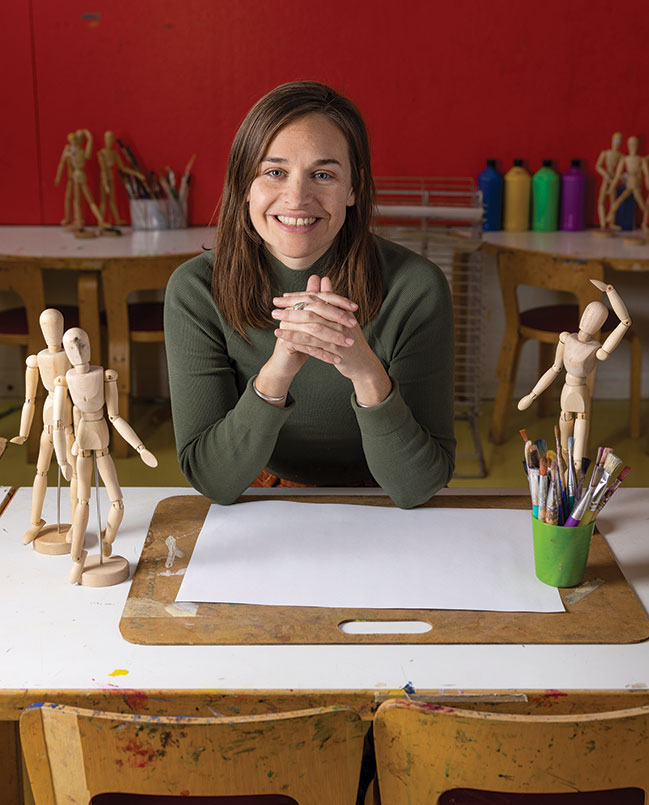 Photo: Joshua Franzos
Photo: Joshua FranzosAs Carnegie Museum of Art’s director of education and public programs since January 2021, Dana Bishop-Root provides direction for an education department that develops and carries out a range of iconic programs, from summer camps and Saturday art classes to K-12 learning and programs for well-being and extended learning. Formerly associate director of Braddock Carnegie Library, she’s a founding member of Pittsburgh-based artist collectives General Sisters and Transformazium, where she participated in the 2013 Carnegie International, creating the Art Lending Library in partnership with Braddock Library. “Everyone who enters the museum already has a relationship with the artwork through their own lived experience,” Bishop-Root says. “Our job as facilitators and educators is to create the spaces where those relationships are valued and built upon.”
Q: What was your path to Pittsburgh?
A: I came to Pittsburgh from New York City in 2007 to work specifically on a project in Braddock. I was working with a group of artists in New York through an artist collaborative called Toy Shop, a street-art collective involved with activating privatized spaces with art. I was also working for an incredible organization called Publicolor, which connects the ways that arts education can complement and fill in what’s missing in a young person’s in-school time. I became interested in neighborhood arts programs that were responsive to the people who create the neighborhoods. As a community anchor, the Braddock Library became the center of this work.
Q: You’re an artistic collaborator, educator, and deeply vested in your community. How do you identify professionally?
A: I think of myself as a facilitator. People ask, “Are you an artist?” No, I facilitate other people’s artmaking practices. An educator? Yes.
Q: What drew you to your role at the museum?
A: [Former curator of education] Marilyn Russell has such an incredible legacy at the museum. We got to work together as partners throughout the years, and it was always so interesting to think about the difference of what a museum does and what a library does. A lot of our work at the library was thinking about the ways libraries can bring art to people and connect art and people and contemporary discourse. And that’s also very much what an art museum is doing. But we were able to do it very differently because of how a library is structured.
The incredible community of staff at the museum has a desire for the museum and its programs to be responsive and reflective of multiple communities. This is where I felt I could participate and share what I’ve learned from my collaborative work in both process and practice. As much as the work is about one institution, I really believe that in order to serve people in multiple communities we have to think about our entire region as an art ecology. In some ways, this work is an extension of what I was doing at the library—it’s about how to build systems of shared resources, how to recognize that our work is all connected in the region.
Q: How does your role contribute to the evolution of the museum in terms of how it welcomes and engages more audiences?
A: I’ve experienced the museum as someone who enjoyed its resources—I’ve attended shows and participated in exhibitions. I’ve experienced the museum through the lens of a community partner. And I’ve experienced the museum in my relationship to other people and other neighborhoods. I’m aware of its multiple layers of histories, and I think part of my role is understanding the ways people have not felt welcome in the museum, the ways that racism has been enacted and structural inequities have existed, and that’s a huge part of the reason why I’m here. I’m very interested in what does it mean to have antiracist practice within an art museum; what does it mean when we talk about having multiple access points, and to recognize our own positions and the ways that we’re maintaining them.
Q: Your team continues to respond to the evolving needs of K-12 teachers. Three years into the pandemic, what are some lessons learned?
A: To me, it’s all about the power of relationships. At the very beginning of the pandemic, [manager of K-12 learning] Meg Scanlon and [associate director of education] Hattie Lehman were able to host very intentional focus groups with educators—to understand what their fears were, what their needs were—and those conversations have continued. The online learning toolkits the team developed were designed based on feedback from in-school educators. This process has pushed the education department.
There is nothing more powerful than standing in front of an artwork and having that in-person experience. I think what the toolkits have done has allowed us to expand the recognition that being in the museum is one experience, and there are ways we can support educators and students to expand upon that experience. We’re going to continue to create virtual experiences, and we are also going to continue to expand how learning and art experiences happen in the museum. We see them as pre-visit and post-visit experiences as well as ways of connecting to homebound students or when in-person field trips are impossible. What can a teacher do in 15 minutes that brings an art experience into their classroom?
Receive more stories in your email
Sign upTags:
Facetime Q&A